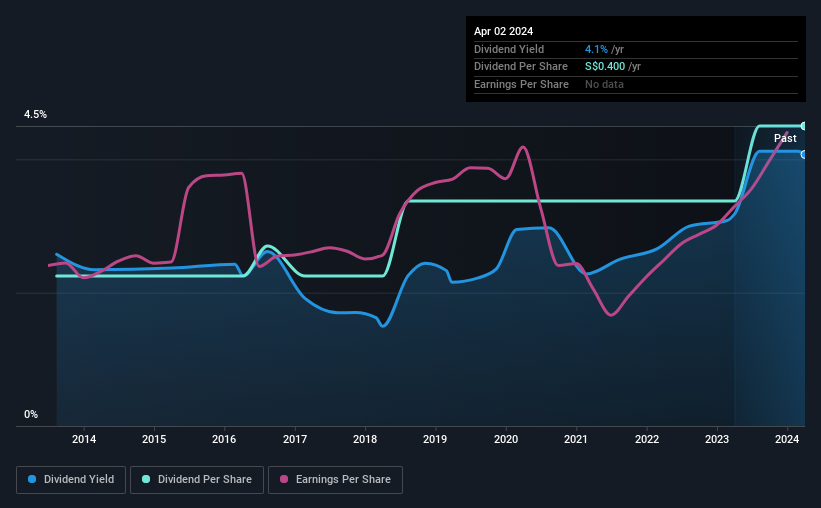Haw Par (SGX:H02) Will Pay A Dividend Of SGD0.20
The board of Haw Par Corporation Limited (SGX:H02) has announced that it will pay a dividend of SGD0.20 per share on the 21st of May. This will take the annual payment to 4.1% of the stock price, which is above what most companies in the industry pay.
View our latest analysis for Haw Par
Haw Par's Dividend Is Well Covered By Earnings
A big dividend yield for a few years doesn't mean much if it can't be sustained. Prior to this announcement, Haw Par's dividend was only 41% of earnings, however it was paying out 161% of free cash flows. The company might be more focused on returning cash to shareholders, but paying out this much of its cash flow could expose the dividend to being cut in the future.
If the trend of the last few years continues, EPS will grow by 3.8% over the next 12 months. Assuming the dividend continues along recent trends, we think the payout ratio could be 42% by next year, which is in a pretty sustainable range.
Dividend Volatility
While the company has been paying a dividend for a long time, it has cut the dividend at least once in the last 10 years. Since 2014, the dividend has gone from SGD0.20 total annually to SGD0.40. This works out to be a compound annual growth rate (CAGR) of approximately 7.2% a year over that time. We like to see dividends have grown at a reasonable rate, but with at least one substantial cut in the payments, we're not certain this dividend stock would be ideal for someone intending to live on the income.
Dividend Growth May Be Hard To Achieve
Given that the dividend has been cut in the past, we need to check if earnings are growing and if that might lead to stronger dividends in the future. However, Haw Par has only grown its earnings per share at 3.8% per annum over the past five years. Growth of 3.8% per annum is not particularly high, which might explain why the company is paying out a higher proportion of earnings. While this isn't necessarily a negative, it definitely signals that dividend growth could be constrained in the future unless earnings start to pick up again.
In Summary
In summary, while it's always good to see the dividend being raised, we don't think Haw Par's payments are rock solid. While the low payout ratio is a redeeming feature, this is offset by the minimal cash to cover the payments. This company is not in the top tier of income providing stocks.
It's important to note that companies having a consistent dividend policy will generate greater investor confidence than those having an erratic one. Still, investors need to consider a host of other factors, apart from dividend payments, when analysing a company. For example, we've identified 2 warning signs for Haw Par (1 is a bit concerning!) that you should be aware of before investing. If you are a dividend investor, you might also want to look at our curated list of high yield dividend stocks.
Have feedback on this article? Concerned about the content? Get in touch with us directly. Alternatively, email editorial-team (at) simplywallst.com.
This article by Simply Wall St is general in nature. We provide commentary based on historical data and analyst forecasts only using an unbiased methodology and our articles are not intended to be financial advice. It does not constitute a recommendation to buy or sell any stock, and does not take account of your objectives, or your financial situation. We aim to bring you long-term focused analysis driven by fundamental data. Note that our analysis may not factor in the latest price-sensitive company announcements or qualitative material. Simply Wall St has no position in any stocks mentioned.

 Yahoo Finance
Yahoo Finance 
